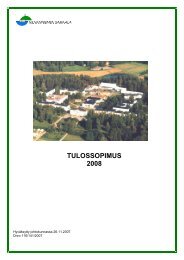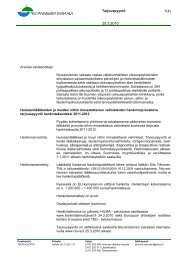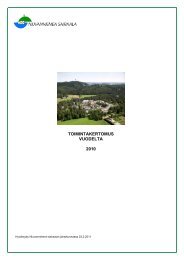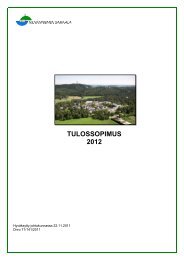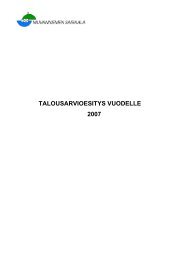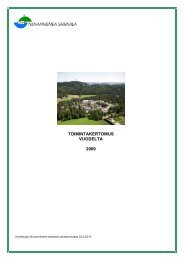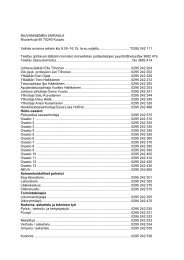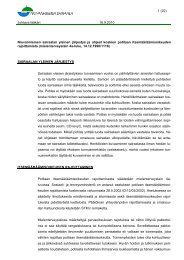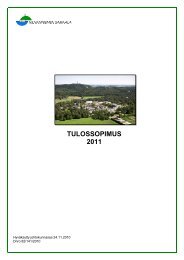Effectiveness of antipsychotic treatments - Niuvanniemen sairaala
Effectiveness of antipsychotic treatments - Niuvanniemen sairaala
Effectiveness of antipsychotic treatments - Niuvanniemen sairaala
Create successful ePaper yourself
Turn your PDF publications into a flip-book with our unique Google optimized e-Paper software.
Skits<strong>of</strong>renian farmakologisen<br />
hoidon vaikuttavuus<br />
Jari Tiihonen<br />
Pr<strong>of</strong>essori<br />
Kuopion yliopiston oikeuspsykiatrian<br />
klinikka, <strong>Niuvanniemen</strong> <strong>sairaala</strong><br />
Skits<strong>of</strong>reniaverkoston symposium<br />
10.–11.9.2009 <strong>Niuvanniemen</strong> <strong>sairaala</strong>
Disclosures and Conflicts <strong>of</strong> Interest<br />
• The study was supported by funding from Annual EVO<br />
Financing (Special government subsidies) from<br />
Niuvanniemi Hospital, Kuopio, Finland. The<br />
researchers were independent from the funder.<br />
• Consultant to Lundbeck, Organon, Janssen-Cilag, Eli<br />
Lilly, and Bristol Myers-Squibb, and has received fees<br />
for giving expert opinions to Bristol Myears-Squibb and<br />
GlaxoSmithKline, and lecture fees from Janssen-Cilag,<br />
Bristol Myers-Squibb, Eli Lilly, Pfizer, Lundbeck,<br />
GlaxoSmithKline, and Astra Zeneca.<br />
• A member <strong>of</strong> Janssen-Cilag Advisory Board since<br />
June 2006, a member <strong>of</strong> Lilly Advisory Board since<br />
October 2006, and has research collaboration with<br />
Organon since 2007.<br />
Jari Tiihonen<br />
University <strong>of</strong> Kuopio 2
<strong>Effectiveness</strong><br />
vs. efficacy<br />
Jari Tiihonen<br />
University <strong>of</strong> Kuopio 3
RCTs<br />
Observational studies<br />
TREATMENT GUIDELINES<br />
Jari Tiihonen<br />
University <strong>of</strong> Kuopio 4
Randomized trials<br />
50 not willing to<br />
participate the trial<br />
40 excluded (co-morbidity,<br />
suicidal or antisocial behavior,<br />
insufficient compliance,<br />
somatic disease)<br />
100 patients<br />
50 willing to participate<br />
10 included<br />
5 disapper/quit<br />
5 patients/results<br />
Jari Tiihonen<br />
University <strong>of</strong> Kuopio 5
<strong>Effectiveness</strong> <strong>of</strong> Antipsychotic Treatments in a<br />
Nation-wide Cohort <strong>of</strong> 2230 Patients in<br />
Community Care after the First Hospitalization<br />
due to Schizophrenia and Schizoaffective<br />
Disorder<br />
Jari Tiihonen, Kristian Wahlbeck, Jouko Lönnqvist,<br />
Timo Klaukka, John P. A. Ioannidis, Jan Volavka,<br />
and Jari Haukka<br />
BMJ 2006;333:224-227<br />
Jari Tiihonen<br />
University <strong>of</strong> Kuopio 6
Background (1/6)<br />
In US, people with serious mental illness die<br />
on the average <strong>of</strong> 25 years earlier than<br />
general population, and it is widely believed<br />
that <strong>antipsychotic</strong> <strong>treatments</strong> and, especially,<br />
the introduction <strong>of</strong> second-generation<br />
<strong>antipsychotic</strong>s during the 1990’s may have<br />
had a major adverse influence on the excess<br />
mortality in schizophrenia. However, no longterm<br />
data have been published to verify this<br />
hypothesis.<br />
Jari Tiihonen<br />
University <strong>of</strong> Kuopio 7
Background (2/6)<br />
Are we killing our patients?<br />
Psychiatry vs. oncology.<br />
Jari Tiihonen<br />
University <strong>of</strong> Kuopio 8
Background (3/6)<br />
It has been stated that there are no clinically<br />
meaningful differences in the efficacy<br />
between <strong>antipsychotic</strong>s, and that the most<br />
important issue is tolerability. Is this true?<br />
Decreased number <strong>of</strong> suicides vs. increased<br />
number <strong>of</strong> cardiovascular deaths?<br />
Jari Tiihonen<br />
University <strong>of</strong> Kuopio 9
Background (4/6)<br />
Figure 2: Second-generation versus first-generation <strong>antipsychotic</strong> drugs—<br />
efficacy in various domains<br />
Data are Hedges’ g (95% CI). Note that the results are significant at p
Background (5/6)<br />
Leucht et al. Lancet 2009;373:31-41
Background (6/6)<br />
How can we compare apples with oranges?<br />
Jari Tiihonen<br />
University <strong>of</strong> Kuopio 12
Methods<br />
Nation-wide registers were used to compare<br />
the cause-specific mortality among<br />
individuals with schizophrenia (N=66,881) vs.<br />
the total population <strong>of</strong> Finland (N=5.2 million)<br />
during the years 1996 to 2006, and to link<br />
data on the use <strong>of</strong> specific <strong>antipsychotic</strong><br />
monotherapies and mortality during the years<br />
1996 to 2006.<br />
Jari Tiihonen<br />
University <strong>of</strong> Kuopio 13
National<br />
Hospital<br />
Discharge<br />
Register<br />
67,000 patients<br />
National<br />
Prescription<br />
Register<br />
156,500,000<br />
DDDs<br />
National<br />
Mortality<br />
Register<br />
19,700 deaths<br />
Adjusted risk <strong>of</strong> death<br />
(574,000 person years)<br />
Jari Tiihonen<br />
University <strong>of</strong> Kuopio 14
• Tiihonen J et al. <strong>Effectiveness</strong> <strong>of</strong><br />
<strong>antipsychotic</strong> <strong>treatments</strong> in a nation-wide<br />
cohort <strong>of</strong> 2230 patients in community care<br />
after the first hospitalization due to<br />
schizophrenia and schizoaffective disorder.<br />
BMJ, 333:224-227, 2006.<br />
• Tiihonen J et al. Antidepressants and the risk<br />
<strong>of</strong> suicide, attempted suicide, and overall<br />
mortality in a nationwide cohort. Arch Gen<br />
Psychiatry, 63:1358-1367, 2006.<br />
Jari Tiihonen<br />
University <strong>of</strong> Kuopio 15
All cause mortality in respect with background<br />
variables in start <strong>of</strong> follow-up.<br />
Variable No <strong>of</strong><br />
deaths<br />
Person<br />
Years<br />
(1000)<br />
Mortality<br />
(1/1000)<br />
Sex<br />
Male 8323 266,240 31.26<br />
Female 11412 307,620 37.10<br />
Time since the onset <strong>of</strong> illness<br />
0–5 8566 234,300 36.56<br />
5–10 3551 100,110 35.47<br />
> 10 7618 239,450 31.81<br />
Age<br />
< 20 56 12,230 4.58<br />
20–30 433 63,620 6.81<br />
30–40 1078 110,210 9.78<br />
40–50 2561 153,540 16.68<br />
50–60 2794 102,700 27.21<br />
60–70 3793 69,020 54.95<br />
> 70 9020 62,540 144.23<br />
Previous hospitalization because <strong>of</strong><br />
ischaemic heart disease yes 6584 63,790 103.22<br />
no 13151 510,070 25.78<br />
attempted suicide yes 209 4,580 45.66<br />
no 19526 569,280 34.30<br />
cancer yes 979 8,040 121.83<br />
no 18756 565,830 33.15
Figure 1a. Relative risk <strong>of</strong> death due to any reason during current<br />
monotherapies.<br />
No <strong>of</strong><br />
Person<br />
Crude rate ratio<br />
Adjusted hazard ratio<br />
deaths<br />
years<br />
(95% CI)<br />
(95% CI)<br />
Clozapine 182 32,000 0.53 (0.43–0.65) 0.74 (0.60–0.91)<br />
Perphenazine 193 17,930 1 1<br />
Polypharmacy 1481 132,320 1.04 (0.89–1.21) 1.08 (0.92–1.26)<br />
Olanzapine 264 25,130 0.98 (0.81–1.17) 1.13 (0.93–1.36)<br />
Thioridazine 227 18,420 1.14 (0.94–1.39) 1.14 (0.93–1.38)<br />
Risperidone 295 19,410 1.41 (1.18–1.69) 1.34 (1.12–1.62)<br />
Haloperidol 135 7,040 1.78 (1.43–2.22) 1.37 (1.10–1.72)<br />
Quetiapine 89 5,360 1.54 (1.20–1.98) 1.41 (1.09–1.82)<br />
Other 1234 70,520 1.63 (1.40–1.89) 1.45 (1.24–1.69)<br />
0 1 2<br />
Deaths during hospital stays <strong>of</strong> longer than 2 days were treated as censored. Adjusted hazards ratios<br />
(HR) were calculated on the basis <strong>of</strong> Cox’s proportional hazards model using sex, age, previous<br />
hospital <strong>treatments</strong> due to attempted suicide, schizophrenia, cancer, ischaemic heart disease, duration<br />
<strong>of</strong> schizophrenia, use <strong>of</strong> antidepressant treatment and time since the start <strong>of</strong> the follow-up as<br />
background variables. Of these, age was the most significant predictor <strong>of</strong> mortality.
Figure 1b. Relative risk <strong>of</strong> death because <strong>of</strong> suicide during current<br />
monotherapies.<br />
No <strong>of</strong><br />
Person<br />
Cr ude rate ratio<br />
Adjusted hazard ratio<br />
deaths<br />
years<br />
(95% CI)<br />
(95% CI)<br />
Clozapine 27 32,000 0.46 (0.28–0.76) 0.34 (0.20–0.57)<br />
Haloperidol 7 7,040 0.54 (0.24–1.22) 0.61 (0.27–1.37)<br />
Polypharmacy 226 132,320 0.93 (0.64–1.34) 0.86 (0.59–1.24)<br />
Thioridazine 27 18,420 0.80 (0.48–1.32) 0.93 (0.56–1.55)<br />
Olanzapine 57 25,130 1.23 (0.80–1.89) 0.94 (0.61–1.45)<br />
Perphenazine 33 17,930 1.00 1.00<br />
Risperidone 47 19,410 1.32 (0.84–2.05) 1.12 (0.72–1.76)<br />
Other 194 70,520 1.49 (1.03–2.16) 1.55 (1.07–2.25)<br />
Quetiapine 19 5,360 1.93 (1.09–3.39) 1.58 (0.89–2.79)<br />
0 1 2 3<br />
Deaths during hospital stays <strong>of</strong> longer than 2 days were treated as censored. Adjusted hazards ratios<br />
(HR) were calculated on the basis <strong>of</strong> Cox’s proportional hazards model using sex, age, previous<br />
hospital <strong>treatments</strong> due to attempted suicide, schizophrenia, use <strong>of</strong> antidepressant treatment, cancer,<br />
ischaemic heart disease, duration <strong>of</strong> schizophrenia, and time since the start <strong>of</strong> the follow-up as<br />
background variables.
Figure 1c. Relative risk <strong>of</strong> death because <strong>of</strong> ischaemic heart disease during<br />
current monotherapies.<br />
No <strong>of</strong><br />
Person<br />
Mortality<br />
Crude rate ratio<br />
Adjusted hazard ratio<br />
deaths<br />
years<br />
(95% CI)<br />
(95% CI)<br />
Clozapine 42 32,000 1.31 0.25 (0.17–0.35) 0.78 (0.54–1.12)<br />
Quetiapine 21 5,360 3.92 0.73 (0.46–1.17) 0.83 (0.52–1.34)<br />
Olanzapine 65 25,130 2.59 0.48 (0.35–0.66) 0.88 (0.63–1.21)<br />
Thioridazine 104 18,420 5.65 1.05 (0.80–1.39) 0.97 (0.73–1.29)<br />
Polypharmacy 522 132,320 3.94 0.74 (0.59–0.92) 0.97 (0.77–1.21)<br />
Perphenazine 96 17,930 5.35 1.00 1.00<br />
Risperidone 119 19,410 6.13 1.15 (0.88–1.50) 1.17 (0.89–1.54)<br />
Other 520 70,520 7.37 1.38 (1.11–1.71) 1.21 (0.97–1.51)<br />
Haloperidol 72 7,040 10.23 1.91 (1.41–2.59) 1.24 (0.91–1.69)<br />
0 1 2<br />
Deaths during hospital stays <strong>of</strong> longer than 2 days were treated as censored. Adjusted hazards ratios<br />
(HR) were calculated on the basis <strong>of</strong> Cox’s proportional hazards model using sex, age, previous<br />
hospital <strong>treatments</strong> due to attempted suicide, schizophrenia, use <strong>of</strong> antidepressant treatment, cancer,<br />
ischaemic heart disease, duration <strong>of</strong> schizophrenia, and time since the start <strong>of</strong> the follow-up as<br />
background variables.
Figure 2. Relative risk <strong>of</strong> death due to any reason vs. cumulative use <strong>of</strong> any<br />
<strong>antipsychotic</strong> medication<br />
Duration <strong>of</strong><br />
Person<br />
No <strong>of</strong><br />
Crude rate ratio<br />
Adjusted hazard<br />
cumulative use <strong>of</strong><br />
years<br />
deaths<br />
(95% CI)<br />
ratio (95% CI)<br />
any <strong>antipsychotic</strong>s<br />
No <strong>antipsychotic</strong>s 146,930 8277 (reference) (reference)<br />
0–0.5 years 59,920 1183 0.35 (0.33–0.37) 0.49 (0.46–0.52)<br />
0.5–1.0 years 14,400 591 0.73 (0.67–0.79) 1.05 (0.96–1.15)<br />
1.0–2.0 years 33,700 1272 0.67 (0.63–0.71) 0.99 (0.93–1.05)<br />
2.0–3.0 years 34,030 1111 0.58 (0.54–0.62) 0.89 (0.84–0.95)<br />
3.0–4.0 years 31,990 891 0.49 (0.46–0.53) 0.81 (0.76–0.87)<br />
4.0–5.0 years 29,920 797 0.47 (0.44–0.51) 0.79 (0.73–0.85)<br />
5.0–7.0 years 57,620 1359 0.42 (0.40–0.44) 0.73 (0.69–0.77)<br />
7.0–11.0 years 165,360 4254 0.46 (0.44–0.47) 0.81 (0.77–0.84)<br />
0 1<br />
All deaths during the follow-up were included in the analysis. Adjusted hazards ratios (HR) were<br />
calculated on the basis <strong>of</strong> Cox’s proportional hazards model using sex, age, previous hospital <strong>treatments</strong><br />
due to attempted suicide, cancer, ischaemic heart disease or other cause and use <strong>of</strong> antidepressant<br />
treatment as background variables. No <strong>antipsychotic</strong>s group refers to patients who had not used any<br />
<strong>antipsychotic</strong> medication at all during the follow-up (N = 18,914).
Results<br />
• Although the proportional use <strong>of</strong> second-generation<br />
<strong>antipsychotic</strong> drugs rose from 13% to 64% during follow-up, the<br />
gap in life expectancy between patients with schizophrenia and<br />
the general population did not widen between 1996 (25 years)<br />
and 2006 (22.5 years).<br />
• Compared with current use <strong>of</strong> perphenazine, the highest risk<br />
for overall mortality was recorded for quetiapine (adjusted HR<br />
1.41, 1.09–1.82), and the lowest risk for clozapine (0.74, 0.60–<br />
0.91; p=0.0045 for the difference between clozapine vs.<br />
perphenazine, and p
Total mortality<br />
1,8<br />
RR<br />
1,6<br />
1,4<br />
1,2<br />
1<br />
0,8<br />
risperidone<br />
clozapine<br />
thioridazine<br />
quetiapine<br />
haloperidol<br />
olanzapine<br />
perphenazine<br />
0,6<br />
0,4<br />
0,2<br />
0<br />
0‐0.5 0.5‐1 1‐2 2‐3 3‐4 4‐5 5‐7 7‐11<br />
years<br />
Figure 3. Total mortality vs. cumulative use <strong>of</strong> specific <strong>antipsychotic</strong> medications. The HRs at 7–11 years compared<br />
with perphenazine were 0.74 (0.45–1.22) for olanzapine, 0.83 (0.65–1.07) for clozapine, 1.10 (0.91–1.34) for thioridazine, 1.11<br />
(0.88–1.41) for haloperidol, 1.12 (0.82–1.53) for risperidone, and 1.54 (1.04–2.29) for quetiapine (at 3–4 years).
Results<br />
No increased total or ischaemic heart<br />
disease mortality was observed after 7–11<br />
years <strong>of</strong> cumulative exposure to<br />
<strong>antipsychotic</strong> <strong>treatments</strong> when compared<br />
with perphenazine use.<br />
Jari Tiihonen<br />
University <strong>of</strong> Kuopio 23
Limitations<br />
• Residual confounding?<br />
• Monitoring?<br />
Jari Tiihonen<br />
University <strong>of</strong> Kuopio 24
Conclusions (1/2)<br />
Long-term use <strong>of</strong> <strong>antipsychotic</strong>s is associated<br />
with lower mortality when compared with no<br />
<strong>antipsychotic</strong> use among patients with<br />
schizophrenia. Second generation<br />
<strong>antipsychotic</strong>s are a highly heterogeneous<br />
group concerning mortality. Surprisingly,<br />
clozapine appears to be associated with a<br />
substantially lower mortality than any other<br />
<strong>antipsychotic</strong>.<br />
Jari Tiihonen<br />
University <strong>of</strong> Kuopio 25
Conclusions (2/2)<br />
The results show that there are large<br />
differences in the suicide mortality, but not<br />
in the rate <strong>of</strong> natural deaths between<br />
<strong>antipsychotic</strong>s.<br />
Suicides at young age result into large<br />
amount <strong>of</strong> life-years lost.<br />
Jari Tiihonen<br />
University <strong>of</strong> Kuopio 26
• Tiihonen J, Lönnqvist J, Wahlbeck K,<br />
Klaukka T, Niskanen L, Tanskanen A,<br />
Haukka J. 11-year follow-up <strong>of</strong><br />
mortality in patients with<br />
schizophrenia: a population-based<br />
cohort study (FIN11 study). Lancet<br />
2009;374:620-627.<br />
Jari Tiihonen<br />
University <strong>of</strong> Kuopio 27
So, in 11-year period…<br />
Jari Tiihonen<br />
University <strong>of</strong> Kuopio 28
… efficacy is important.<br />
Jari Tiihonen<br />
University <strong>of</strong> Kuopio 29
Thank you!<br />
Jari Tiihonen<br />
University <strong>of</strong> Kuopio 30



